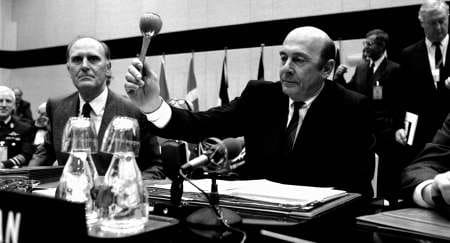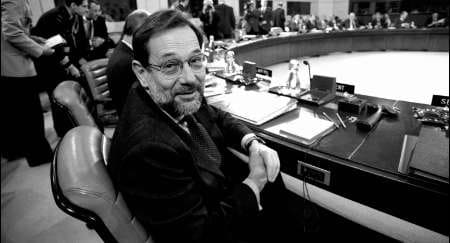The position of leading NATO is unrecognisable from its early roots. Ryan Hendrickson explains how the role has changed, and why.

Manfred Wörner (above) brought a strong personality and dedication as Secretary General. © NATO Media Library.

Negotiation skills have proved to be one of the key qualities needed in the role of Secretary General, as illustrated by Javier Solana. © NATO Media Library.
As NATO reaches 60, its first Secretary General, Lord Hastings Ismay, would undoubtedly have been amazed to see the transformation of the NATO Secretary General role.
From a position that was essentially managerial in nature, designed to advance intra-Alliance consultation, the modern Secretary General has evolved into a position with much wider responsibilities in shaping NATO’s operational and strategic role in the world.
At its birth in 1949, NATO did not have a Secretary General. With the onset of the Korean War, the Allies created the Supreme Allied Commander, Europe in an effort to increase military integration across the Alliance. The first SACEUR (Supreme Allied Commander Europe), American General Dwight Eisenhower, brought new prestige and respect to NATO. But it was soon clear that the office of the SACEUR was not enough to promote the necessary political dialogue and cooperation among the Allies.
In response, the office of the Secretary General was created at NATO’s three-year anniversary in 1952. At its core, the Secretary General is there to help the Allies find consensus. The Secretary General has no vote in the North Atlantic Council (NAC), and thus in many respects, is simply a servant of the Allies, trying to build cooperation and meaningful consultation. The powers of this office are then quite limited in scope. In his first years as Secretary General, Lord Ismay was kept in the background, was not permitted to speak without approval from the Allies, and did not even chair Council meetings until 1955.
Yet since then, NATO’s political leader has evolved into a key, and at times, central decision-maker among the Allies. He has shaped how the Alliance evolved, defining key strategic concepts as the Alliance adapted to new security circumstances.
While many within NATO Headquarters understand the importance of this office, many histories and past analyses of NATO have devoted very little to the roles played by the 11 Secretaries General. This absence is unfortunate given the profoundly important influence NATO’s political leader can and has exercised.
For example, among the past Secretaries General, Lord Peter Carrington has received almost no historical attention or credit for his leadership at NATO, which ran from 1984 to 1988. Carrington himself admits in his memoirs the frustration he felt during his service at NATO, due in part to the absence of any real formal power or authority provided to the Secretary General—a condition that Ismay and other predecessors most certainly understood.
Yet upon his selection as Secretary General, former assistant Secretary General to NATO, Robin Beard noted that Carrington “projected honour” and generated a new level of respect for the Alliance. Former American Ambassador to NATO, David M. Abshire said that Carrington led the Alliance using his skill, good humour and grace in dealing with the many different personalities across the Alliance. Carrington’s personal diplomatic skills were critical in helping to find consensus during some very difficult moments among the Allies.
NATO’s ninth Secretary General, Javier Solana, also demonstrated the potential influence that this office can wield. His legacy as NATO’s political leader is especially significant.
Solana’s quiet diplomacy and skills with language also came into play in 1998, when debate within Brussels ensued over how to respond to the violence and aggression in the Balkans.
At the Madrid Summit in 1997, when the debate over NATO’s expansion became contentious among the Allies, author Ronald D. Asmus noted that the Allies turned to Solana to find a way out of this contentious political environment. After consultation with the Allies, Solana succeeded in finding the eventual compromise that resulted in membership invitations to the Czech Republic, Hungary and Poland.
Solana’s quiet diplomacy and skills with language also came into play in 1998, when debate within Brussels ensued over how to respond to the violence and aggression in the Balkans. Again, it was Solana who identified that all the Allies could agree that a “sufficient legal basis” existed for NATO to authorise the use of force in the Balkans, which eventually resulted in Operation Allied Force in 1999.
At the onset of military action in 1999, Solana again played a key role in advising the SACEUR, General Wesley Clark, on the kinds of military targets that the Allies would support. Again, Solana played a key role in allowing the operation to move forward as rapidly as possible, while maintaining political consensus among the then 19 members of the Alliance for military action.
Certainly, among NATO’s most influential Secretaries General, Manfred Wörner’s legacy merits special consideration. Wörner, NATO’s first and only German Secretary General, brought a special set of skills to the Alliance, which in many ways shaped what the Alliance is able to achieve today.
First, Wörner had the extraordinary intellect to frame issues and questions into the broader strategic interests of the Alliance. In part, his ability to think strategically helped move the Alliance toward its new Strategic Concept, which was agreed at the Rome Summit in 1991. This set the stage for NATO to begin peacekeeping and crisis management operations, which have in many ways defined NATO’s role in the world today.
In addition, Wörner saw, much earlier than some, the advantages of extending NATO’s outreach to the Soviet Union and later to the newly formed democracies of Eastern Europe, all in an effort to integrate them into the rest of democratic Europe. Through his own initiative, he used the influence of his office to foster new relationships across Eastern Europe, which set the foundation for the major membership expansions that came at the Madrid, Prague, and Bucharest Summits. Wörner’s early vision helped to establish the political groundwork for NATO to move east, and later to assist in the modernisation and democratisation of many of these formerly communist militaries.
Wörner’s influence was also felt in the NAC, such that a number of his contemporaries believed that consensus was not going to be reached unless he also approved of the policy in question. The informal authority that he exercised came due to his wide diplomatic contacts among the Allies, his command of the specific issues in question, and the force of his personality.
As has been documented, after rising from his sick bed in Aachen, Germany and traveling to Brussels for this meeting, his presence was instrumental in producing the necessary consensus for military action.
Among his most memorable occasions in the NAC was his attendance at a critical April 1994 Council session. He was suffering from cancer, which eventually took his life in August 1994. With evident weight loss, his physician at his side, and intravenous feeding tubes visible from his shirt collar, Wörner successfully lobbied the Allies for a NATO military response to the repeated attacks on Bosnian civilians. As has been documented, after rising from his sick bed in Aachen, Germany and traveling to Brussels for this meeting, his presence was instrumental in producing the necessary consensus for military action.
Leading in a new security climate, when the Alliance has taken on new roles in fighting terrorism in Afghanistan, and conducting peacekeeping and humanitarian support activities in Kosovo, Sudan, and Pakistan, Jaap de Hoop Scheffer has also produced his own legacy as NATO’s political leader.
Like Wörner, de Hoop Scheffer has stretched NATO in directions beyond what some thought was possible prior to his selection as Secretary General. In his efforts to generate new partnerships to fight terrorism, de Hoop Scheffer has carried NATO’s message across the globe, including trips to Asia, the Middle East and Australia, all of which was unprecedented.
Much like his predecessor Lord Robertson’s mantra for more “capabilities, capabilities, capabilities,” de Hoop Scheffer has often stressed the need for additional and more cooperative defence spending efforts across the Alliance. His goal, much like Robertson’s, is for an alliance that can rapidly respond to new and immediate security challenges and crises. De Hoop Scheffer has continued to push for these investments, which nearly all military analysts concur is in the Alliance’s best interest.
But de Hoop Scheffer’s clearest priority was NATO’s engagement in Afghanistan. From his first day as Secretary General through to 2009, de Hoop Scheffer has used his office to ensure that he did everything possible to increase NATO’s chances for success in Afghanistan. In doing so, he has often called for more resources, both civilian and military, to promote democracy and peace in Afghanistan. While NATO still has many challenges to face in Afghanistan, which de Hoop Scheffer has readily acknowledged, his focus and commitment to the mission’s success will be among his most significant legacies as Secretary General.
The Alliance is about to move into a new era with new leadership. The individual who holds this position can make a profound difference in NATO’s ability to act, evolve, and respond to new circumstances. And the trend, from Ismay to de Hoop Scheffer, is that the Secretary General’s role has continued to grow in stature.
From his first day as Secretary General through to 2009, de Hoop Scheffer has used his office to ensure that he did everything possible to increase NATO’s chances for success in Afghanistan.
